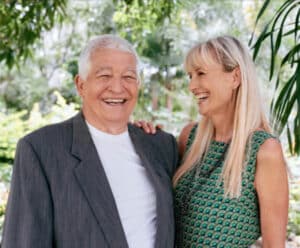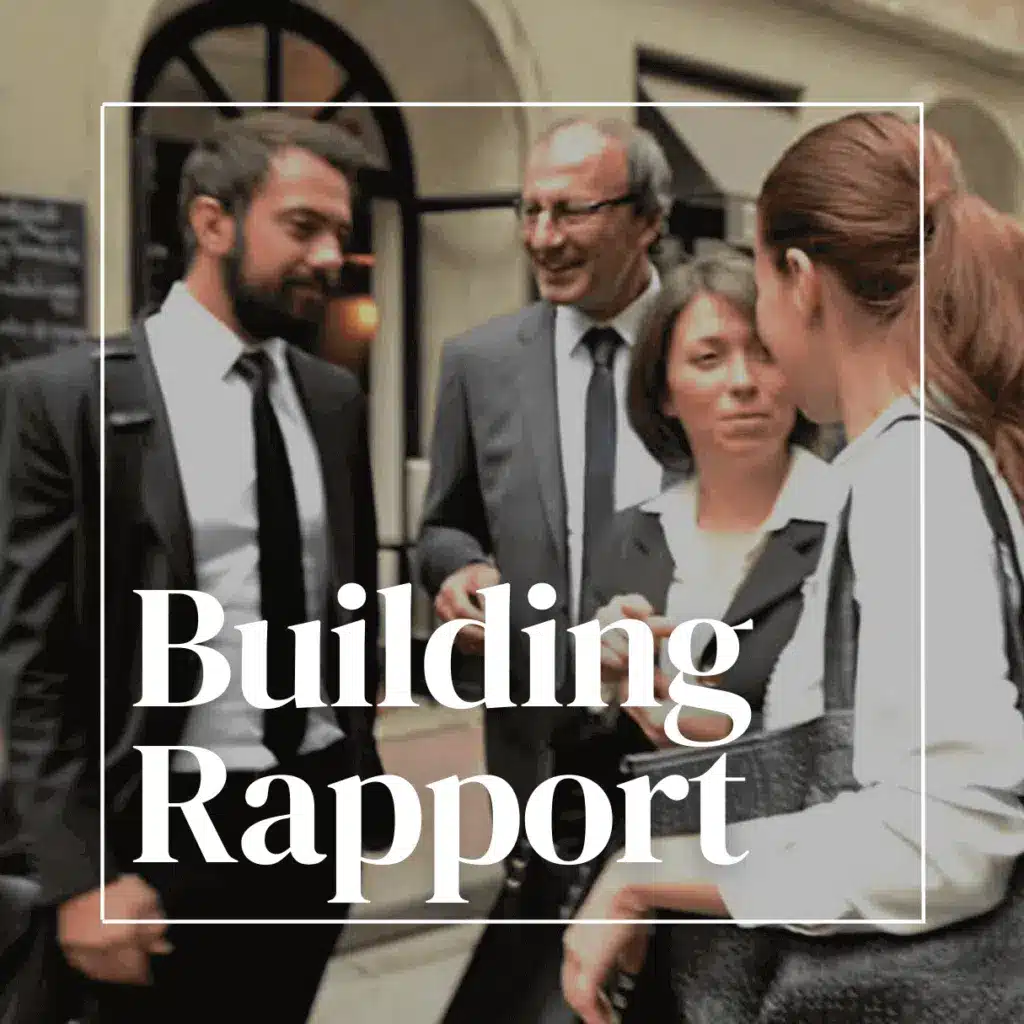Conquer the Conversation
PART TWO of 3 part series
No matter what business you’re in, you’re in the people business first. To build successful and rewarding relationships in your personal and professional life, you need to make meaningful connections with other people from all walks of life. In this article, you’ll learn the practical steps to help you nail this important life skill.
When it comes to conversation, getting started can be the hardest part and it’s also the number one reason most people avoid networking. The keys to overcome this barrier are simple and once you practice and master these techniques, you will be well on your way to become a Rapport Building Rockstar!
Have you read part one of this series: How to become a Rapport-Building Rockstar

Open-Ended Questions: Unlock the Door to Conversation & Connection
The fastest way to get a conversation going and take the pressure off yourself is to ask Open-Ended questions. These questions usually begin with who? What? Why? When? Where? Open ended questions get the other person doing most of the talking and reveal to you their motivations, preferences and attitudes– which are critical to uncover when you’re selling your idea, product or service – or even if you’re on a first date!
Next time you are going to meet someone for the first time, come up with a list of open-ended questions and memorise them. Tailor your questions to the environment and context of your meeting and include questions that will help you learn about the other person. This will help you establish common ground, which is a fundamental key to building a strong foundation for an ongoing relationship.
Examples of Open-Ended Questions
1. “What brings you here today?”
2. “How did you get interested in …
3. “What do you enjoy most about you work?”
4. “What inspired you to pursue this line of career?”
To take this technique to the next level, use the following tips to encourage the other person to keep talking.
-
- If someone is looking disinterested, gently touch them on the elbow for 3 seconds or less. This regains their attention without invading their personal space.
- People love to talk about their favourite subject – themselves – so repeat the technique of asking Open-Ended questions to make them re-engage and participate When you want them to pay attention to you again, ask lots of questions that get them talking about themselves and their interests.
- To keep the conversation flowing use minimal encouragers, which are sounds like ‘mmm hmmm’… ‘ah’… ‘I see’, and phrases like; “…meaning?”
- Finally, use open body language gestures, including a wide smile with teeth visible, palms up, elbow touching, and leaning in. We lean towards people and events we like, we lean away from people and events we don’t like. Always keep your feet pointed toward them, not away.
Practice these simple techniques, you’ll learn things you never thought possible and the person you’re with will have a feeling that there is something about you they really like.

Active Listening: Your Ticket to Trust

Active Listening – the art of truly hearing and understanding what someone is saying, with the goal of building trust and rapport. Before your next meeting, program your brain like a GPS by clearly visualising yourself hearing and understanding the other person or people and gaining their trust by feeding back to them what you hear them saying. See the end result – this could be a successful meeting or the beginning of a new partnership – by seeing the benefit for yourself, this won’t be just another technique you forget to use. You’ll shift your mindset to want to build stronger relationships because of what is in it for everyone – including you!

Approach conversations with an open mind and positive attitude. This means refraining from making assumptions about the other person and avoiding negativity or defensiveness. Active listening will help you to conquer the conversation. And by asking Open-Ended questions and showing genuine interest in the other person’s perspective, you can create a safe and inviting space for them to share their thoughts and feelings. Additionally, it is important to share your own experiences and opinions without dominating the conversation. Finding common ground and building on it can help create a shared understanding and sense of connection.
Look for Silent Signals: the Body Language cues that reveal what others are truly thinking!
Body Language also plays a crucial role in effective communication, building rapport and creating trust. Paying attention to the other person’s body language and gestures, tone of voice, and facial expressions can help you gauge their emotional state and adjust your approach accordingly.
By understanding body language signals, you’ll create the impression that you are showing empathy and respect for others’ views. Avoid interrupting or dismissing the other person’s perspective, and make a conscious effort to understand where they’re coming from.
Top 5 positive and negative body language signals to look for in meetings:
Negatives:
-
- Body facing away
We turn our bodies away from what we find distasteful or uninteresting and this results in a person having their feet pointed in the direction they’d like to go, for example the door. - Crossing the body
We cross our body with our arms, hands or legs when we are not interested in what we are hearing or experiencing. - Eye contact
We decrease our eye contact when we lose interest in the person or subject. - Concealing the palms
The palms of our hands are rarely flashed when we’re disinterested in the subject, topic or person. - Fidgeting or tapping
These are classic signs of disinterest and include things like checking their phone often.
- Body facing away

If you see any of these gestures, ask a straight question: ‘I can see you have a question. Would you mind if I ask what it is?’. Then you have an opportunity to respond and get back in the conversation.
Positive Gestures to look for:
-
- Leaning forward: Leaning slightly forward can indicate interest, engagement, and a desire to connect.
- Smiling: A genuine smile can convey warmth, friendliness, and approachability.
- Open arms and palms: This gesture indicates openness, honesty, and a willingness to listen.
- Eye contact: Maintaining eye contact during a conversation can demonstrate attentiveness, sincerity, and respect.
- Nodding: Nodding in agreement or acknowledgement can show that you are actively listening and understanding what the other person is saying.
It’s not what you say: powerful Body language strategies to give you the edge
One of the most effective ways to build rapport is through positive body language. This means using open and inviting gestures, maintaining eye contact, and using a relaxed posture. When you’re engaged in conversation, try to lean in slightly and nod your head to show that you’re listening. Avoid crossing your arms or legs, as this can create a barrier and make you appear defensive or closed off. By using positive body language, you’ll create a sense of warmth and approachability, which can help to establish a strong connection.
3 simple and powerful Body Language techniques:
- Keep your fingers together – People who keep their fingers closed and their hands below their chin when they talk command the most attention. Using open fingers or having your hands held above the chin is perceived as less authoritative.
- Keep your elbows out – Sitting with your elbows on the armrest of a chair is perceived as a position of power and conveys a strong, upright image. Humble, defeated individuals let their arms drop inside the arms of the chair and they keep their elbows close to their bodies to protect themselves. They are perceived as fearful or negative, so avoid sitting like this.
- Mirror their body language – Mirroring the other person’s body language and speech patterns builds rapport quickly. In a new meeting with someone, mirror his sitting position, posture, body angle, gestures, facial expressions and tone of voice.
Before long, they’ll start to feel that there’s something about you they like – they’ll describe you as easy to be with.
When meeting couples or groups, watch for who mirrors whom to uncover the decision-maker. If one person makes the initial movements and another copies, you will know who to ask for a final decision.
Check out our body language article here.
Finally, it’s essential to follow up and stay in touch to nurture the relationship over time. This can be as simple as sending a friendly message or checking in periodically to show that you value the connection.
By mastering these skills, you can create meaningful connections with others that can lead to positive outcomes and enrich your life in countless ways.
1. Start with an open mind and positive attitude
2. Practice active listening and ask open-ended questions
3. Pay attention to non-verbal cues and adjust your approach accordingly
4. Share your own experiences and opinions, but avoid dominating the conversation
5. Find common ground and build on it
6. Show empathy and respect for others’ views and feelings
7. Follow up and stay in touch to nurture the relationship
Copyright Allan Pease
About the Authors:
Over 5 decades of studying and teaching human communication and body language, Allan and Barbara Pease have identified the Body Language and People Skills that underpin charisma and harmony in personal and professional relationships. Across their shared 18 International Top 10 Bestsellers, the dynamic duo has distilled the most powerful rapport-building techniques into easy to learn methods to help millions of people around the world to live a more positive and successful life.
Share This

Want FREE Help To Connect & Influence People Better?
Subscribe now and receive free growth strategies delivered to your inbox.



